Toshiba KIRAbook Ultrabook Review
by Dustin Sklavos on May 9, 2013 12:01 AM ESTDisplay Quality
The Toshiba KIRAbook's claim to fame is its 2560x1440 13.3" IPS display, and that display really is a beauty. Viewing angles are excellent as one would expect, but there are two very minor issues. First, response time is good, but not great, and there's minor ghosting when dragging a window or the start screen. There's also backlight bleed on the edges of the display that's fairly typical of an edge-lit panel. Neither of these are dealbreakers and I'd still very easily take the KIRAbook's display over just about any competing notebook's, including the 1080p IPS stunner in the Dell XPS 13.
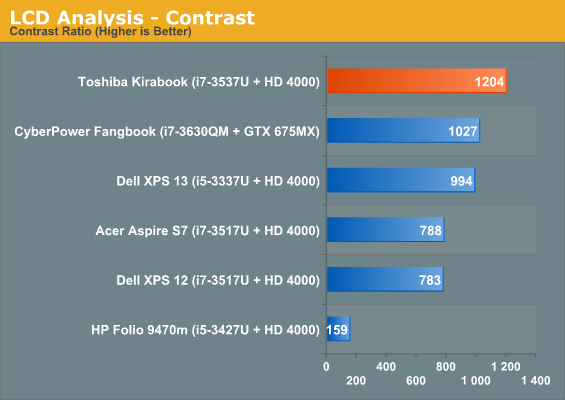
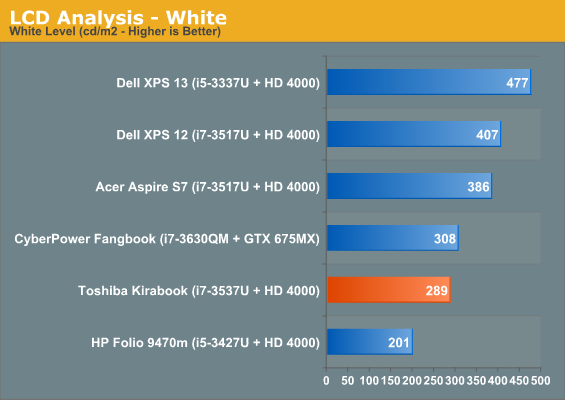
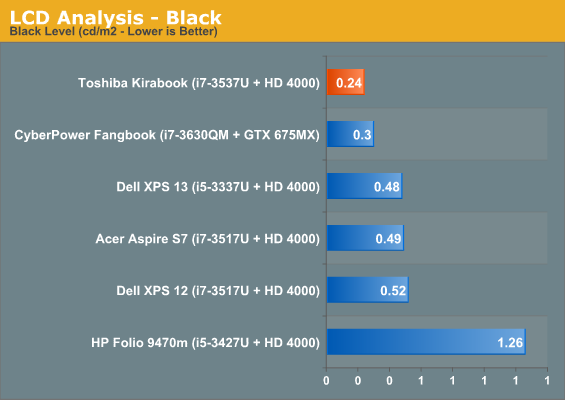
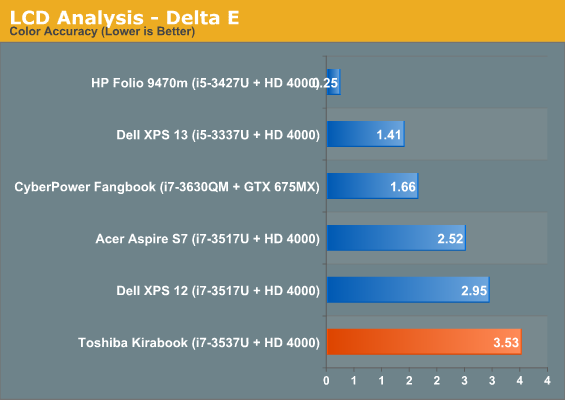
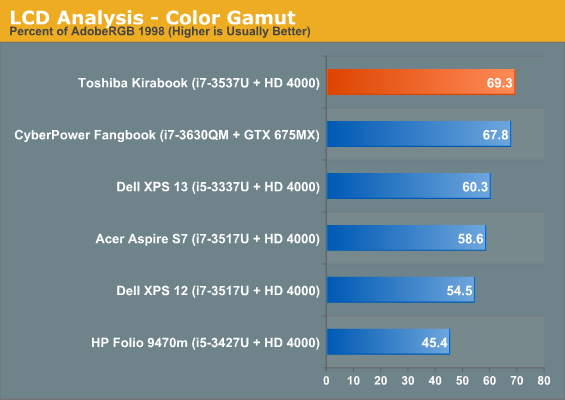
Everything about the KIRAbook's display screams quality except the measured delta-E, but in practice I found the display color to be plenty accurate and certainly worthy of the packed-in Adobe Photoshop Elements. Color gamut's quite good, brightness is beautiful without being excessive, and black levels are stellar. It's difficult not to be impressed with this panel.
Battery Life
When dealing with a high-resolution IPS panel, especially one as bright as the KIRAbook's, it can be hard to predict just how the battery life will play out. That's compounded by the fact that space for battery cells inside an ultrabook is always at a premium. The 52Wh integrated battery is at least slightly above average, though.
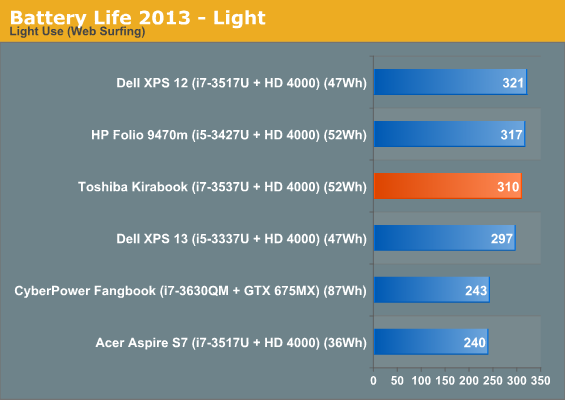
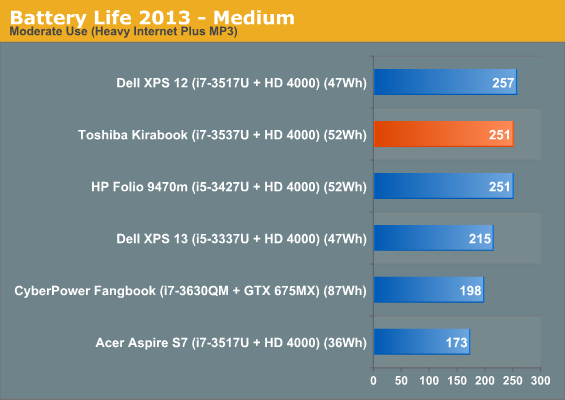
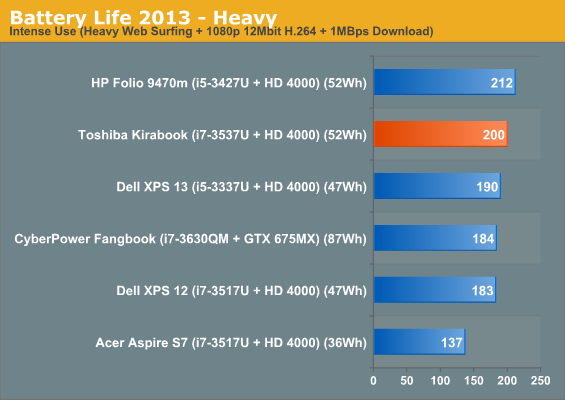
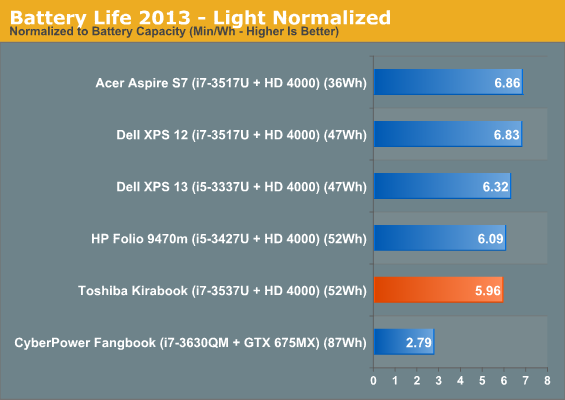
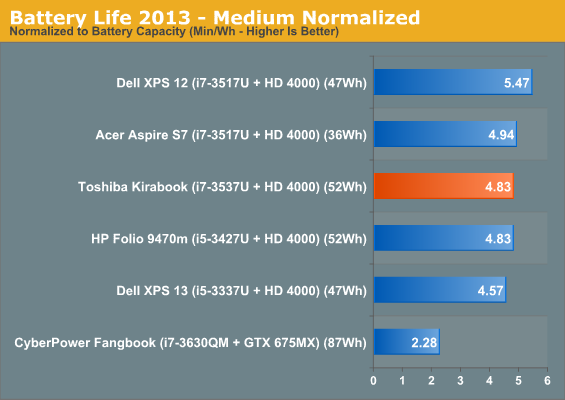
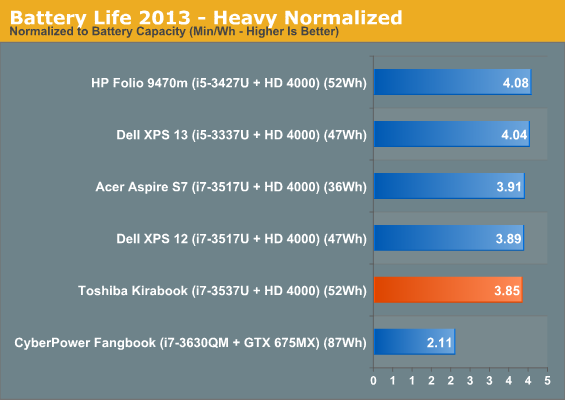
In broader terms, the KIRAbook produces battery life competitive with other ultrabooks in its class. When you normalize it, things look slightly worse, but not substantially so. There's clearly a very minor trade-off taking place to get that better display quality. That trade-off is largely negated by the slightly larger battery and substantially superior panel.
Heat and Noise
Toshiba made a big deal about the KIRAbook's cooling mechanism, but in practice this cooling system is essentially identical to the one in the Portege Z835. That worked out great for the Portege when we reviewed it, which featured a turbo-free Sandy Bridge low-voltage Core i3, but the KIRAbook has a harder time dealing with the horsepower of the i7-3537U.
Thermals under load are quite good, but noise is much less so. Idle noise is stellar; the KIRAbook is basically inaudible. Sustained load hitting the CPU causes the fan to spin up gradually, and again I lament the bottom-intake fan. During Cinebench R11.5 testing the i7-3537U spent most of its time at 2.3GHz, and it did take a good minute or so before noise the fan started spinning up, and a low narrow whooshing was eventually accompanied by a slight whine. Thankfully surface temperatures never got uncomfortable, though I'd recommend against touching the area near the hinge on the inside of the notebook.
A far as cooling systems go, this isn't necessarily a bad one, but I'd almost give up some of the ports on one side of the KIRAbook just to get side-oriented cooling. The Acer Aspire V5-171 I reviewed was a budget notebook just a touch too fat to get the ultrabook branding (to say nothing of the dismal stock hard drive), but that extra girth also allowed it to integrate a vastly superior cooling system that made it much more practical in the long run.


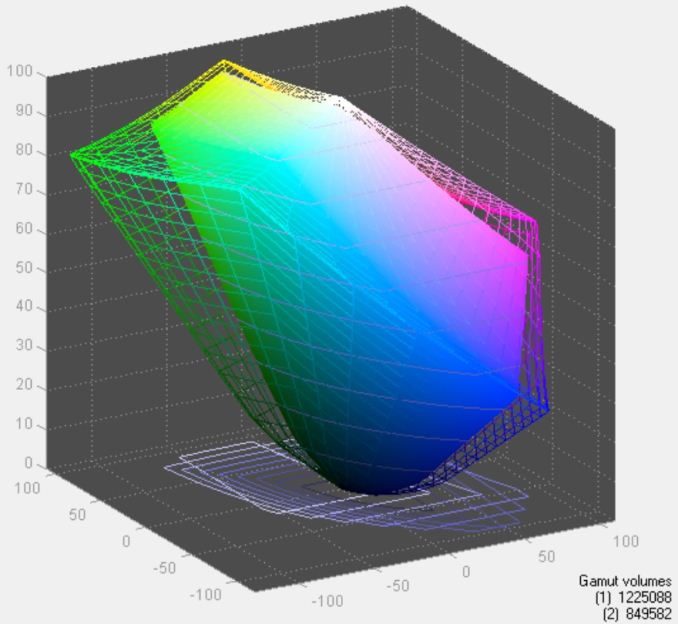
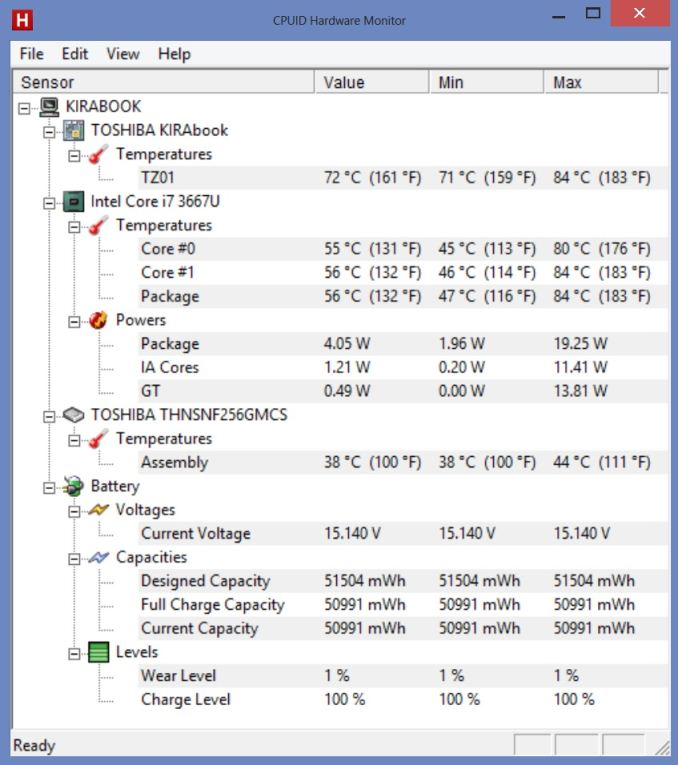








110 Comments
View All Comments
baronmog - Thursday, May 9, 2013 - link
Wow. I was reading the specs and mostly thinking, "that's pretty cool," or "eh, I could live with that," until I got to the "no 5GHz wifi support." Dude, that doesn't cut it. The ThinkPad my work provided to me a year ago has 5 GHz support. My Galaxy S3 (from a year ago) has 5 GHz support. My Nexus 10 has 5 GHz support. The Netgear router I bought almost a year ago has 5 GHz support...Seriously, what was Toshiba thinking?
danstek - Thursday, May 9, 2013 - link
$1599 but no dual band WiFi is just lulz. Seriously, all single band WiFi adapters and routers at this point should just be banned from existence.Hrel - Thursday, May 9, 2013 - link
AgreedSirKronan - Saturday, May 11, 2013 - link
Yup!CajunArson - Thursday, May 9, 2013 - link
I have a 5 year old Core 2 notebook with Intel 5Ghz wireless-N support fer crying out loud!elitegibson - Thursday, May 9, 2013 - link
I think that's funny because my 2008 Toshiba Satellite has 5ghz wifi. I would probably cost them like $3 per laptop to put a good wifi card in it. Major misstep Toshiba.chrnochime - Thursday, May 9, 2013 - link
So one manufacturer finally makes a laptop with a good screen and all you have to complain is no 5GHz support? BTW 5GHz has crappy wall penetration so it's not like you're going to be using it anywhere BUT completely open space anyway. Besides there are crapload of 5GHz wifi adapters to buy to remedy this.sosrandom - Thursday, May 9, 2013 - link
Yup 5Ghz is pretty bad on my router, upstairs in my plaster board house the signal is really weak.Gigaplex - Thursday, May 9, 2013 - link
I get better reception and speed on 5GHz than 2.4GHz throughout my entire (admittedly smallish) apartment. I'm certainly not willing to give it up especially if it's not user serviceable so I can switch in my own WiFi adapter.SirKronan - Saturday, May 11, 2013 - link
A sleek, expensive, premium looking/feeling ultrabook is not supposed to have unsightly things hanging out of it and taking up your precious few USB ports... just to get 5GHz. This is one standard where costs shouldn't have been cut. It makes an otherwise premium device at least "seem" less premium to consumers, and will chase away many "premium" buyers that expect 5GHz as a standard.